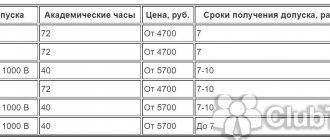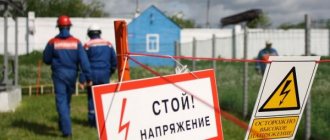Our center conducts courses and assigns electrical safety group 2 up to 1000 V. Ready documents are sent to graduates by mail or courier. Delivery throughout Russia. Let's figure out what electrical safety group 2 is, what personnel it applies to, to whom it is assigned and how to obtain it.
| Course program | “Norms and rules for working in electrical installations” |
| Form of study | Remotely |
| Duration | 72 ak/h |
| Price | 4000 rubles |
| Final documents | Electrical safety certificate group 2 with entry into the register, protocol. |
| Deadlines for receiving documents | Up to 10 working days from the date of application |
Required Skills
- Basic technical knowledge in the field of power tools, electrical installations, electricity.
- Knowledge of the risks and hazards that arise due to improper handling of electricity.
- Knowledge and ability to apply in practice precautionary measures and special devices to eliminate the danger of electric shock to workers and others, fire due to current, and damage to equipment.
- Ability to provide first aid to victims before doctors arrive.
How to improve the electrical safety group?
Testing employees' knowledge is divided into primary and periodic (regular and extraordinary).
An initial knowledge test is carried out for workers who first entered a job related to the maintenance of electrical installations, or when there is a break in knowledge testing for more than 3 years; next - in the order established in clause 1.4.20. Etc. dated January 13, 2003 N 6 PTEEP); and extraordinary - in the manner established in clause 1.4.23. Etc. dated January 13, 2003 N 6 PTEEP).
clause 1.4.20. The next inspection should be carried out within the following periods:
- for electrical personnel directly organizing and carrying out work on servicing existing electrical installations or performing adjustment, electrical installation, repair work or preventive tests in them, as well as for personnel who have the right to issue orders, orders, and conduct operational negotiations - once a year;
- for administrative and technical personnel not belonging to the previous group, as well as for labor protection specialists authorized to inspect electrical installations - once every 3 years.
The time of the next test is set in accordance with the date of the last knowledge test.
clause 1.4.23. An extraordinary knowledge test is carried out regardless of the date of the previous test:
- when new or revised rules and regulations come into effect for the Consumer;
- when installing new equipment, reconstructing or changing the main electrical and technological circuits (the need for an extraordinary check in this case is determined by the technical manager);
- upon appointment or transfer to another job, if new responsibilities require additional knowledge of rules and regulations;
- in case of violation by employees of the requirements of regulations on labor protection;
- at the request of state supervisory authorities;
- according to the conclusion of commissions investigating accidents with people or disruptions in the operation of an energy facility;
- when increasing knowledge to a higher group;
- when testing knowledge after receiving an unsatisfactory grade;
- if there is a break in work in this position for more than 6 months.
How to obtain a certificate “Electrical safety group 2”
The certificate is issued only after mastering the corresponding program and passing the electrical safety exam for the 2nd group of admission at Rostechnadzor.
Individuals who have completed grades 9-11 of secondary school can apply for training. No special technical education is required. Experience with electrical installations is not required.
The second group is a category that can be obtained without having the first group. This is the entry level, the first step in climbing the qualification ladder. Having received a certificate for electrical safety of group 2, over time it is easy to get to the fifth.
Electrical safety training group 2 up to 1000 V
Sometimes applicants are interested in why training in electrical safety for group 2 is only up to 1000 V. We answer: the opportunity to work with electrical installations over 1000 V arises only after receiving group 3.
According to the law (clause 5 of Rules No. 328n, clause 1.4.7 of PTEEP), electrical safety group 2 is assigned after mastering a 72-hour program. The convenience of distance courses is that the educational material is studied at any time. In this case, you can always contact the teacher using chat, phone or email.
The program contains complete information about safety when working with electrical installations, power tools and electrical appliances. It includes main topics:
- Basic information about the technical condition and design of electrical installations.
- Danger and risk when working with electric current.
- Safety precautions to follow.
- Regulatory documents required for work.
- Study of warning systems in the event of an emergency.
- Rules of conduct in case of an electrical accident.
- Primary medical care for victims.
Assignment of electrical safety group 2 occurs after certification. To study, you only need access to the Internet and the desire to obtain the necessary qualifications.
Curriculum and program
Responsibilities of workers with the 2nd group of electrical safety clearance
Employees are not allowed to connect electrical equipment or carry out repair work on their own.
List of responsibilities:
- Know how to provide first aid.
- Know how to act in the event of emergency situations, including fires, accidents, and incidents.
- Report any malfunction or suspected malfunction of technical devices to your supervisor.
Do not start work without passing a knowledge test or without a break in work for more than 3 years.
What groups are there in electrical safety?
To understand what groups exist in a given industry, it is necessary to tell where these groups are formed from. “Electrical”, like any other area of safety, is divided into categories (“groups” is one of the types of subcategories).
Anyone who studied more or less passably at school should know from physics lessons that electrical equipment is divided into voltages “Up to 1000V” and “Up to and Above 1000V”. Also in “electricity” there are such concepts as “non-electrical” and “electrical” personnel.
These are the main criteria in Electrics on which groups depend. There is one group of non-electrical personnel, and six of electrical personnel.
Well, more about everything.
Personnel.
Non-electrical.
It contains one group - I. As the name implies, it is assigned to workers whose duties include the use of electrical appliances that pose minimal danger to humans (office equipment, hairdresser’s tools, etc.) and do not require separate safety training.
Usually these are office employees, employees of beauty salons, shops, etc. Assigned by a specially appointed employee of an organization with group 3 (no need to go to supervision) by conducting instructions with a log entry for non-electrical personnel of group 1.
No certificate will be issued.
Electrotechnical.
Contains six groups (2, 3, 4 Up to 1000v, and 3, 4, 5 “Before and Above 1000v”). Supervised category (it is necessary to conduct a knowledge test at Rostechnadzor and obtain a certificate).
It is divided into voltage - “Up to 1000V” and “Up to and Above 1000V”. Which voltage should be assigned to an employee depends on the voltage of the equipment used in the organization.
Let me get ahead of myself right away - “Before and Above” cannot be assigned earlier than “Before”.
Below one step (or one might say a subcategory) are groups. For voltage “Up to 1000V”, 2, 3 and 4 groups are assigned. “Before and Above 1000v” - 3, 4 and 5.
Up to 1000v.
Group II.
Assigned to novice electricians, electricians, management personnel, as well as specialists who perform their immediate duties using power tools. You can work ONLY under the supervision of a senior person.
To qualify for this category, the employee must have basic knowledge of electrical equipment and electrical installations, know the dangers of electric current, basic precautions, first aid, etc. (POTEU app. 1)
III group.
After 3 months of experience in the previous category (2 months, 1 month, the period depends on education, more details in Appendix 1), you can be assigned a third admission group. This level gives you the right to perform your duties independently, allows you to connect power tools to the network, and is awarded 1 grade in electrical safety.
IV group.
The owner of this voltage group Up to 1000V reaches the peak of his career. With this category, a specialist can perform any complex work according to the staffing schedule (within the above voltage, of course). Also, the fourth group may be required by the assistant manager assigned to the role of responsible for electrical equipment.
Up to and Above 1000v.
In organizations that use electrical equipment with a voltage of over 1000v, specialists must be assigned clearance up to and above 1000v. This category (unlike Up to 1000V) starts with group 3. You can apply for it ONLY after a certain period of experience with group IV up to 1000 years.
Group III essentially corresponds to group II UP TO 1000V. Those. You can only work under supervision.
IV - you can work independently.
V approval group Up to and Above 1000V is the highest level of career growth for specialists in the field of electrical safety. Assigned to those responsible for electrical facilities, chief power engineers, and specialists performing high-risk work with electrical equipment with voltages over 1000V.
To whom is it assigned?
Persons working in certain professions need to obtain qualification group No. 2 in electrical safety. These are specialties that are associated with the conditions listed in the “Rules for the technical operation of consumer electrical installations” (PTEEP) and in the “Rules for labor protection during the operation of electrical installations” (POTEE).
Each individual enterprise has a list of specific positions and jobs related to the need for access to electrical equipment. Approval of such a list is the responsibility of the head of the organization.
These positions include:
- electric welders;
- machine equipment operators;
- crane operators;
- boiler equipment operators;
- signalmen;
- thermists;
- drivers of special cargo transport;
- persons working with power tools;
- electricians on probation.
The video from the channel “STBSH CHU ODPO” tells who at the enterprise must undergo training in electrical safety rules.
Categories of electrical technical personnel
All electrical personnel are usually divided into several categories:
| Staff | Functions |
| Administrative and technical | Managers and organizers of the work process |
| Operational | Operations management workers who service electrical installations. Employees prepare workplaces and directly supervise the process. |
| Repair | Personnel who provide:
|
| Operational and repair | Employees are engaged in repair work. Personnel must be prepared for prompt maintenance of electrical installations. |
Requirements for candidates
Officials or workers wishing to receive electrical safety group 2 must meet the following requirements:
- be at least 18 years of age;
- have two months of experience working with electrical devices.
Employees can be admitted to the test only if they have completed ES training lasting at least 72 hours. The exam is available to workers in the electrical sector without work experience or relevant education: applicants must have access group No. 1.
Electrotechnological personnel
The situation is completely different with the Electrotechnological personnel. According to the definition, Electrical Technological Personnel means personnel of production workshops and areas that are not part of the energy service of the organization, operating electrical technological installations and having electrical safety group II and higher (in their rights and responsibilities they are equal to electrical personnel and are technically subordinate to the energy service of the enterprise) ; personnel whose main component in the technological process they control is electrical energy (for example, electric welding, electric arc furnaces, electrolysis, etc.), who use hand-held electric machines, portable power tools, lamps, etc. in their work. I deliberately use the second part of the definition highlighted because it is with this that significant leapfrog and confusion in categorization are associated. Who is classified as non-electrical and electrical technical personnel? This question will first have to be answered by the one who will compile the “List of Positions...”. The gradation is fully entrusted to the employer and the person authorized by him. There are also errors that the inspector can point out... The main thing is to understand that, first of all, electrical engineering personnel include persons who cannot perform their job duties without the use of any electrical equipment. Thus, if the employee’s position sounds like an electric welder, ultrasound doctor, x-ray technician, etc., then it should be understood that such a person cannot perform his job duties without the use of appropriate electrical equipment, which means he must be classified as electrical engineering personnel , train at least group II in electrical safety (for example, a group of at least III is provided for a welder) and ensure recertification once a year. But, for example, positions such as general practitioner, hairdresser, accountant, etc., may involve the use of some kind of electrical equipment, but from time to time. That is, in the course of their main activity, an employee may not use it at all: a hairdresser can cut hair using only scissors, an accountant and a therapist can do without the use of computers or any other electrical equipment, so they can be classified as non-electrical personnel and limited only by holding an annual lecture.
It is important to remember that, in accordance with clause 1.4.3 of PTEEP, “managers who are directly subordinate to electrical engineering personnel must have an electrical safety group no lower than that of subordinate personnel. They must provide technical guidance to these personnel and supervise their work.”
I would like to note several features when finding the line that turns non-electrotechnical personnel into electrotechnical personnel. For example, in my practice, there have been cases when supervisory authorities issued orders to conduct training and certify Group II electrical safety for workers in such professions as computer operators and programmers. It would seem, what type of activity can now do without the use of personal computers? Nevertheless, the order was given in accordance with the above definition. That is, these workers in their production activities cannot do without the use of electrical equipment, which is a computer.











